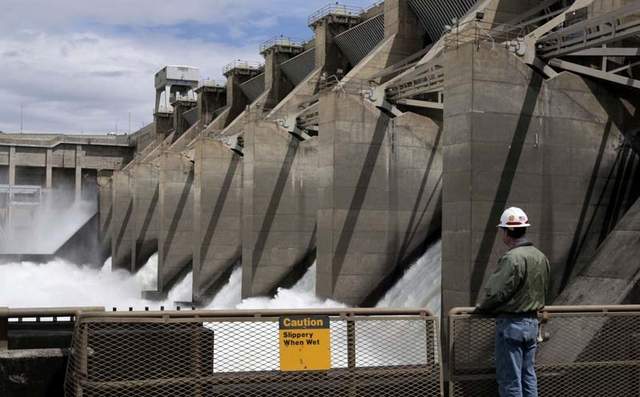forum
library
tutorial
contact

BPA's Annual Costs for Basin Fish and Wildlife
Mitigation Expected to Nudge Above $500 Million
by Staff
Columbia Basin Bulletin, July 11, 2014
|
the film forum library tutorial contact |

|
BPA's Annual Costs for Basin Fish and Wildlife
by Staff
|
 Newer obligations, old obligations and other factors and agreements continue to drive up funding for what Bonneville Power Administration officials say is likely the country's largest ecosystem improvement program.
Newer obligations, old obligations and other factors and agreements continue to drive up funding for what Bonneville Power Administration officials say is likely the country's largest ecosystem improvement program.
The overall annual costs for Bonneville's Columbia River basin fish and wildlife program this fiscal year and next is expected to nudge above $500 million, and rise up nearer $550 million for fiscal years 2016-2017. That annual spending has risen from about $330 million during the 2007-2009 time frame.
"It's a lot of money, but it's a lot of progress too," Lorri Bodi, BPA's vice president of Environment, Fish and Wildlife, told the Northwest Power and Conservation Council Wednesday.
BPA markets power generated in the federal Columbia/Snake river hydro system and is obligated under the Northwest Power Act to mitigate for dam impacts on fish and wildlife. As a federal agency, Bonneville also has obligations under the Endangered Species Act and under long-held treaties with Columbia Basin tribes to restore fish and wildlife populations.
The spending obligations rose in 2008 with completion of a federal plan – NOAA Fisheries' Federal Columbia River System biological opinion -- aimed at improving ESA-listed salmon and steelhead survivals by investing in habitat, and improved hatcheries and hydro system passage. In that same year BPA and federal agencies that operate the dam signed "Fish Accords" with treaty tribes and states that pledged more than $1 billion in additional spending on fish and wildlife projects over the period ending in 2018.
The restoration work, which began well before 2008, has produced results, Bodi told the Council.
"We have the highest dam and in-river survival that we've had since before the dams," she said.
The federal dams have been extensively overhauled to improve passage of juvenile and adult salmon, steelhead and lamprey. About 75 percent to 99 percent of juvenile fish now pass dams through the highest survival routes, avoiding turbines.
Fish travel times have also been significantly improved by surface passage systems that have been installed at the dams, BPA says.
BPA has also protected and restored hundreds of thousands of acres of fish and wildlife habitat throughout the Columbia River basin to offset the impacts of federal dams. Much of that work has been carried out via projects recommended for approval by the NPCC, which has at the direction of the Northwest Power Act developed a scientific program for judging whether proposals enhance the mission of protecting, restoring and enhancing fish and wildlife in the Columbia Basin.
"Studies show this landscape-level habitat work is making a difference," according to Bonneville.
The BPA funding has:
That $500 million spending total includes estimates of $254 million in FY 2014 and $260 million in FY2015 for the "integrated program," which is largely implemented through the NPCC. It aims to meet both BPA's Northwest Power Act and ESA obligations.
Another large share is for "fish related" operations and maintenance and other non-capital activities carried out by the U.S. Army Corps of Engineers and the Bureau of Reclamation (i.e., O&M of fish facilities at the federal mainstem dams and Corps/Reclamation mitigation hatcheries), and U.S. Fish and Wildlife Service (for hatcheries under the Lower Snake River Compensation Plan – 11 hatcheries and 18 satellite facilities). The hydroelectric "share" of such expenses is typically about 80 percent.
Annual budgets also include debt service -- the projected amortization, depreciation and interest payments for investments directly funded through BPA borrowing, as well as capital investments by the Corps and Reclamation funded by the U.S. Treasury and reimbursed by BPA. Those investments include the construction of fish passage devices at the dams and of hatcheries, and the acquisition of land in order to insure habitat protections.
The plus $500 million total does not include so-called foregone revenue, which is a calculation of how much power generating value is lost because of actual hydro operations, such as spill, aimed at improving fish survival.
The fish and wildlife capital debt service this year and next is expected to approach $175 million annually.
Actual fish and wildlife spending in FY2015, not including debt service, is expected to total $343.5 million. That includes about $102 million for Accord projects, $98 million for non-Accord projects that are BiOp related, $42 million for integrated program projects that are neither accord nor BiOp related, $32.7 million for LSRCP hatcheries and $18 million for overhead. That $343.5 million total also includes $51.8 million in capital expenditures.
BPA is a self-financed federal agency. The agency pays its expenses from revenues it receives from the sale of power and transmission services to eligible customers. BPA establishes rates to be charged for power and transmission services in a rate proceeding, a formal evidentiary hearing process.
Related Pages:
BPA Sets Rates for 2018-19; Includes Surcharge to Recover Costs Associated with Increased Spill by Staff, Columbia Basin Bulletin, 7/28/17
learn more on topics covered in the film
see the video
read the script
learn the songs
discussion forum
